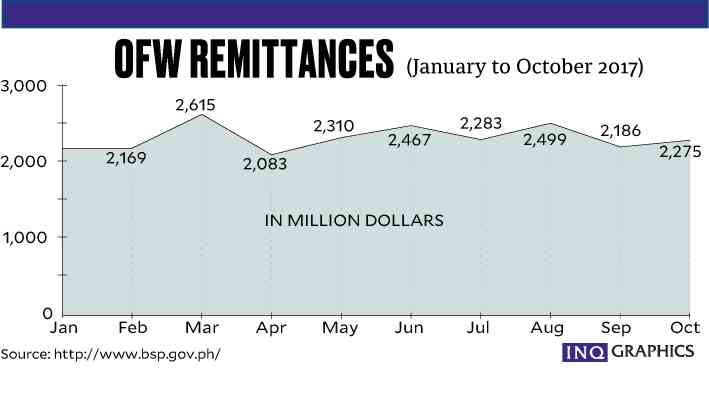Cash sent home by Filipinos living and working abroad grew 8.4 percent in October, the fastest pace in seven months, to $2.28 billion ahead of the Christmas holiday season.
The latest Bangko Sentral ng Pilipinas data released Friday showed that cash remittances that month rose from $2.1 billion in October last year, reversing the 3-percent decline a year ago.
The remittances that flowed through banks in October also exceeded September’s $2.19 billion, hence staying above the $2-billion mark for 21 straight months.
The remittances growth posted in October was the highest since March’s 10.7-percent jump, a reversal of the 8.3-percent drop in September.
In a statement, BSP Governor Nestor A. Espenilla Jr. said the bulk of the cash remittances in October came from the United Arab Emirates and the United States.
From January to October, cash remittances grew 4.2 percent to $23.06 billion from $22.12 billion in the first 10 months of 2016.
The rise in 10-month remittances was boosted by the increase in remittances from land- and sea-based workers, which both grew by 4.2 percent compared to the level posted a year ago, Espenilla said.
Four-fifths of the end-October cash remittances were from Filipinos in Germany, Hong Kong, Japan, Kuwait, Qatar, Saudi Arabia, Singapore, the UAE, the United Kingdom and the US.
Cash remittances are projected to reach a record $28 billion by the end of the year.
Last year, cash sent home by overseas Filipinos through banks reached a record high of $26.9 billion, up 5 percent from 2015’s $25.6 billion.
Remittances are the country’s biggest source of foreign exchange income, insulating the domestic economy from external shocks by ensuring the steady supply of dollars in the system.
Also, these cash transfers are a major driver for domestic consumption, hence contributing to strong economic growth even when the global economy is slowing down.
The World Bank sees remittance flows to the Philippines hitting nearly $33 billion this year amid a global economic recovery.
“Remittances to the Philippines continue to remain resilient despite the political uncertainties in the Middle East and are expected to grow by 5.3 percent in 2017, slightly higher than the estimated 4.5-percent increase in 2016,” the Washington-based multilateral lender said in its Migration and Development Brief report released last October.
The Philippines was poised to be the third-biggest remittance-receiving country this year with $32.8 billion, after India’s $65.4 billion and China’s $62.9 billion, the World Bank’s latest estimates showed.
Worldwide, “remittances to low- and middle-income countries are on course to recover in 2017 after two consecutive years of decline,” the World Bank said in a statement.
“Officially recorded remittances to developing countries are expected to grow by 4.8 percent to $450 billion for 2017. Global remittances, which include flows to high-income countries, are projected to grow by 3.9 percent to $596 billion,” the World Bank added.
